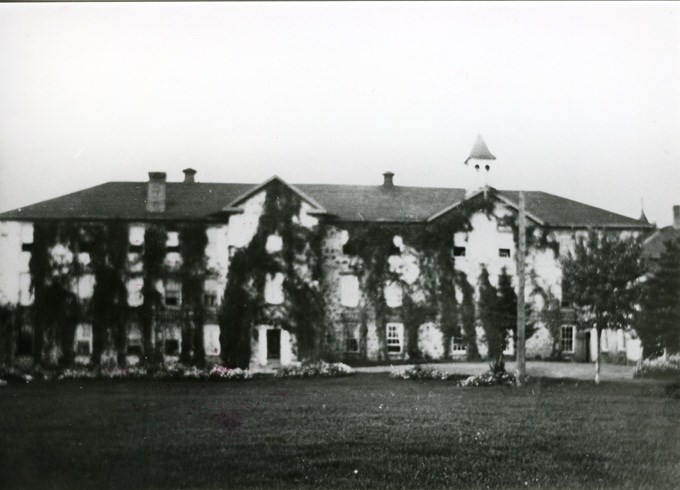From the archives of the Sault Ste. Marie Public Library:
*************************
The site of Algoma University was the original home to the Shingwauk Residential School which was built in 1874 and officially opened in 1875.
However, the ground work for this school actually began as early as 1832 when the Province of Upper Canada established a mission in Sault Ste. Marie to provide religious and vocational education to the local native population.
Lieutenant Governor Sir John Colborne appointed William McMurray to complete this task.
Funding for this venture was provided by the “Society for Converting and Civilizing the Indians in Upper Canada” (The Toronto Society).
In 1833 a schoolhouse and church was built, which was named the “teaching wigwam” in Garden River with McMurray being placed in charge.
By the late 1830s, the Anglican mission had established a large following.
A notable convert was Old Chief Shingwauk, who also had represented the Ojibway peoples at the signing of the Robinson-Huron Treaty in 1850.
Funds for the mission soon dried up under the new Lieutenant Governor Sir Francis Bond Head, who disapproved of the attempts to “civilize and evangelize” the native population.
The funding was removed and the mission was left vacant for 15 years until Old Chief Shingwauk’s sons, Chief Augustin Shingwauk and Chief Henry Buhkwujjenene Shingwauk wanted to see the teaching wigwam rebuilt.
The time between 1855 and 1871 was under the guidance of Rev. James Chance who struggled with no money or resources.
He was visited by Edward Francis Wilson, who was interested in missionary work among the First Nations People.
Wilson returned to Garden River in 1872, once he was ordained, and began working with the two Chiefs, Augustin and Henry Shingwauk, to secure funding for the teaching wigwam.
Their efforts were successful and the Shingwauk Industrial Home was built in Garden River on September 22 1873 with Rev. Wilson spearheading the project.
The school was only open for six days when a fire destroyed the building.
Immediately after the fire Rev. Wilson secured funding for a second building which would be located this time in Sault Ste. Marie on the site of the current Algoma University.
They were offered a grant of $500 if they located the new school within the boundaries of Sault Ste. Marie.
The new Shingwauk Home was officially opened on August 2, 1875 by Bishop Hellmuth of Huron and Bishop Fauquier of Algoma.
Rev. Wilson was the first principal and was in charge of 50 boys from Ojibway settlements in Garden River, Walpole Island, Sarnia and Muncey.
It was established as a boys-only school.
The girls had a separate school called Wawanosh Home, which was located 5 km north of Sault Ste. Marie opening on August 19, 1879 with 14 female students.
Rev. Wilson soon realized that with the low enrollment at Wawanosh, both schools needed to be amalgamated.
In the late 1880s Rev. Wilson began working to incorporate Wawanosh School with Shingwauk Residential School.
However, due to poor economic times in the 1890s there was little support for expanding the school program. It was not until 1900 that the Wawanosh girls school was eventually consolidated into Shingwauk but by this time Rev. Wilson had already resigned in 1893.
It is believed that Wilson resigned in part due to poor health and possibly frustration over not being able to consolidate the two schools.
In 1935, a new Shingwauk Residence was constructed on the same site, which is the current Algoma University building you can see while driving down Queen Street today.
Shingwauk remained open as a residential school until 1970 when it was closed and taken over by Algoma University.
In an interview with Shirley Horn, former Shingwauk student and now Algoma University Chancellor, she remembers ‘a lot of hard work — cleaning, cooking and building maintenance — and a “white” curriculum taught only half the day, so that students would receive enough education to become domestic workers once they left the school, but not enough to continue on to college.’
Horn also states that a lot of the children experienced physical and sexual abuse, leading her to become one of the founding members of the Children of Shingwauk Alumni Association.
Other former students recalled that there was never enough food to eat and some students, particularly the older boys, would resort to stealing food in order to keep themselves fed.
Speaking English was mandatory and if students were caught speaking other languages they knew they would be punished.
Shingwauk Residential School is a reminder of a darker side of not only our local history but Canadian history as a whole.
The recently published Truth and Reconciliation Report has tried to bring to light the crimes committed against the First Nations people in order to educate future generations and attempt to heal these deep wounds and build a better future.
*************************
Each week, the Sault Ste. Marie Public Library and its Archives provides SooToday readers with a glimpse of the city’s past.
Find out more of what the Public Library has to offer at www.ssmpl.ca and look for more Remember This? columns here
